#i can find him mentioned on some other comedian's wikipedia page however .. but not one of his own
Explore tagged Tumblr posts
Text
i FINALLY after about 2 years of holding onto it, listened to that album i found outside by a dumpster in NJ going in blind (Dave Starr's The Nearer the Bone the Sweeter the Meat). and its a comedy show. from '62. and boy did this dude yuk it up about faggots huh. and thats whats just on the "day show" side
its being sold a couple places online (amazon and ebay) but i cant find any infos about it other than its cover art being on a few "the most disturbing cover arts ever" lists. and im glad im not the only one who thinks its creepy
there's a video on youtube about it that was taken down (probably for the content??) .. if i cant find anything else on him i'll download this from the record player i bought and upload it on like archive.org just so that its preserved. i dont like .. AGREE with the content but i think it should be preserved
#he made a joke about a fag getting a hysterectomy and it made my eyes bug out LOL . did not expect that#cannot find a wikipedia page for this man also. like at all#i can find him mentioned on some other comedian's wikipedia page however .. but not one of his own#hmmm ...#my copy looks like it was signed on the back from him too. i wonder if its legit.#i dont know that he was big enough for this to even be verified if i sought out getting it checked#but who knows. i'd love to be able to have it be really his
1 note
·
View note
Text
A Strong and Loving World

WATCHMEN #12 OCTOBER 1987 BY ALAN MOORE, DAVE GIBBONS AND JOHN HIGGINS

SYNOPSIS (FROM DC DATABASE)
Midnight, November 2, 1985.
Most of New York City has been devastated by the psychic trauma caused by the instant death of Ozymandias' "alien."
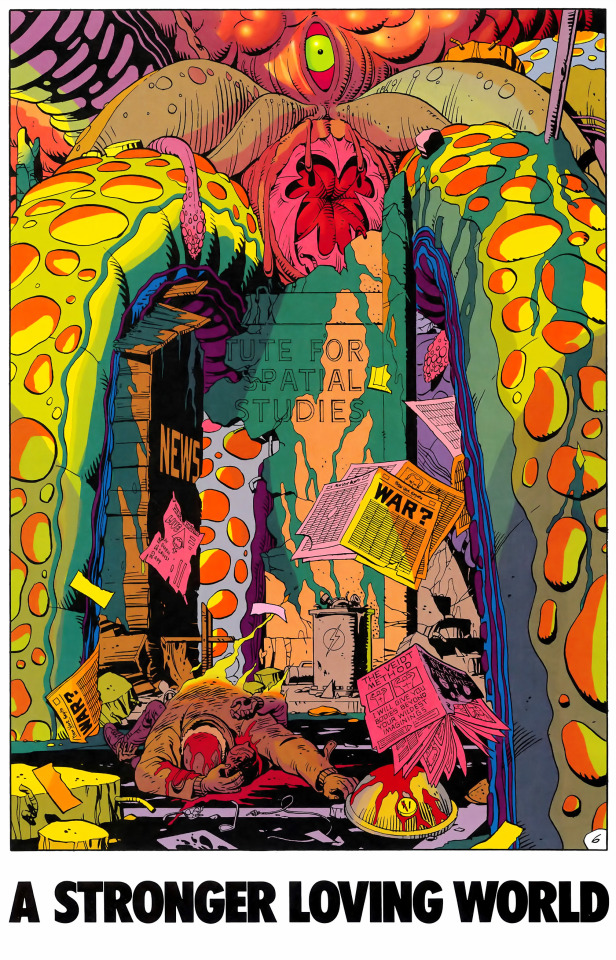
Dr. Manhattan and a heavily distraught Laurie arrive in the city too late as they tour the devastation. After they have seen enough, the two teleport away to the South Pole, to follow a trail of tachyon particles that Dr. Manhattan senses will lead to the source of the disturbance. Before they left, Laurie picks up a gun from the deceased Detective Steven Fine.
At Karnak, Ozymandias continues to detail his plan to Rorschach and a disbelieving Nite-Owl. He explains he cloned the brain of the dead psychic Robert Deschaines and having it augmented and programmed with horrible visions and concepts of aliens, so that the mental transmissions given off at its death would affect anyone around it who managed to survive the initial psychic blast. Thus forcing humanity to cast aside their petty enmities and focus on a common alien enemy. But to ensure this plan to work, Veidt necessarily eliminated anyone involved in his plan. Although Veidt admits he hasn't any ideas what he will do with Rorschach and Nite-Owl.
Manhattan and Laurie soon arrives to Karnak, where Manhattan confront Veidt. Veidt hinders Manhattan with a tachyon generator that interferes with Doctor Manhattan's ability to see the future, and then disintegrates him in an intrinsic field subtractor at the regrettable cost of Veidt's pet Bubastis. This act is witness by Laurie, who then shoots Veidt with Fine's gun. However, Veidt use his newfound, and untried, ability to catch the bullet. After subduing Laurie, Veidt begins to lecture the costumed heroes that their "obvious heroism" is redundant and that their failure to prevent "Earth's salvation" will usher a new era for humanity. But his speech is cut short when to Veidt's surprise, Manhattan restores himself. Before Manhattan could pass judgement on Veidt, the world's smartest man make one last trick by showing everyone news broadcasts of the aftermath of the disaster in New York, which has cost the lives of over two million people, which has prompt an end to hostilities between the U.S. and Soviet Union and calling for peaceful cooperation against Veidt's faked alien threat.
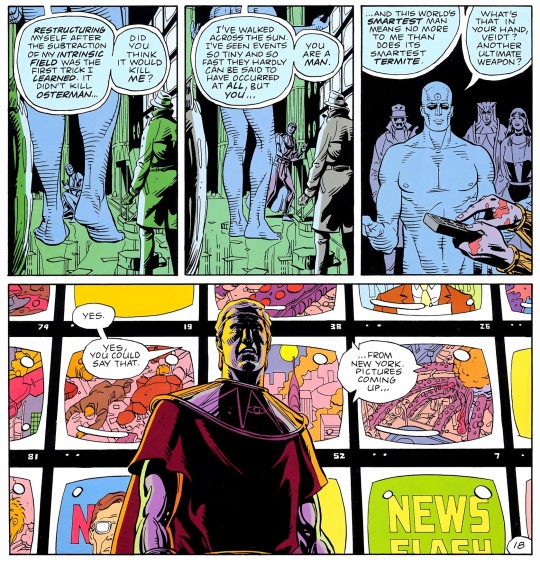
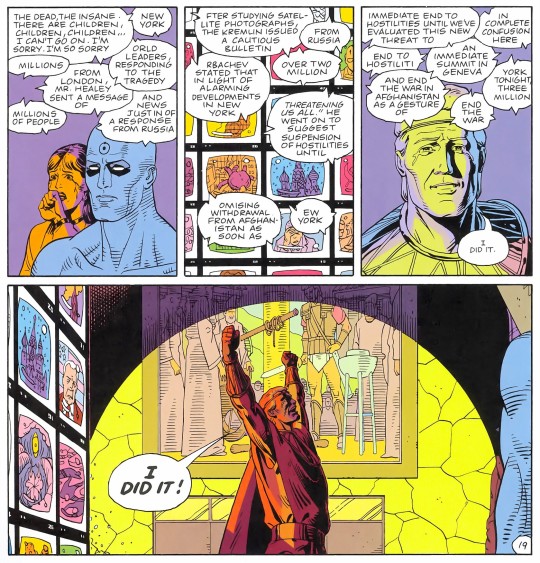
Veidt revels in his victory for bringing Earth into a "utopia" and convinces almost everyone present that exposing the truth would bring a permanent end to world peace. Manhattan, Laurie, and Dan reluctantly agree to concealing Veidt's truth. But Rorschach refuses to compromise with keeping the secret and proceed to leave despite Dan's pleas. Veidt is seemingly unconcerned of Rorschach being a "reliable witness" before retiring to meditate in his ornery and offering Dan and Laurie a stay in his home. Laurie and Dan found a private room to reflect on their decision and they settle down to make love.
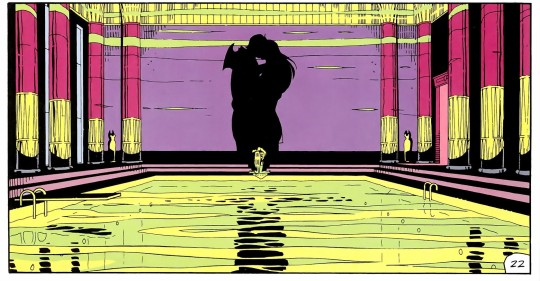
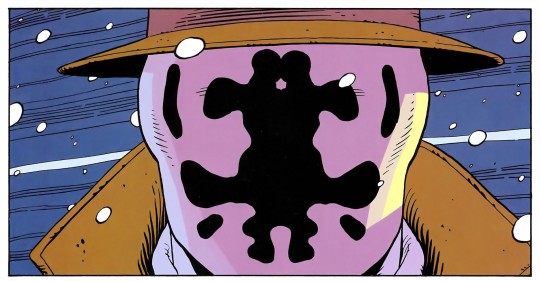
Outside, Rorschach tries to start up his hoverbike but is stop by Manhattan. Rorschach takes off his mask, knowing that Veidt's new utopia is to be protected with the cost of his own life and prompts Manhattan to reluctantly disintegrate him. Manhattan walks back inside the retreat, where he finds Dan and Laurie asleep together and smiles at Laurie's newfound love and happiness and walks out of the room to meet Veidt. The two discuss about Veidt's well-intention reasons for ensuring world peace at the cost of millions of human lives. Veidt is surprise that Manhattan regained interest in human life, to which Manhattan suggests that he may "create some [human life]" in another galaxy that he will be travelling to. But before Manhattan could go, Veidt ask him if his plan worked out in the end. Manhattan smiles and enigmatically replies that "nothing ever ends." Veidt is left totally confuse by Manhattan's words and appears to be in doubt as to whether or not his plan was successful.
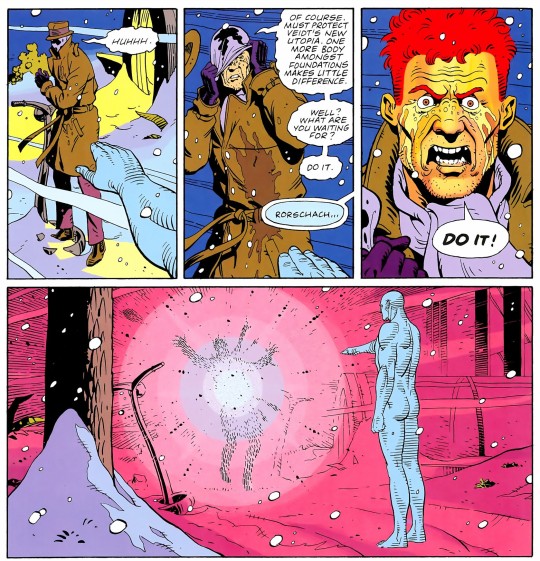
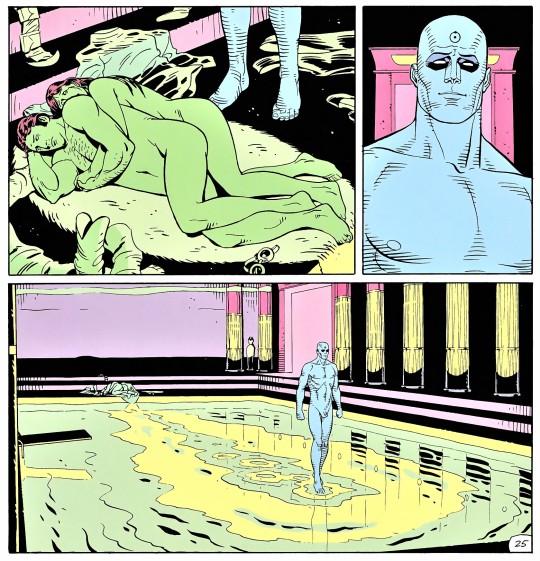
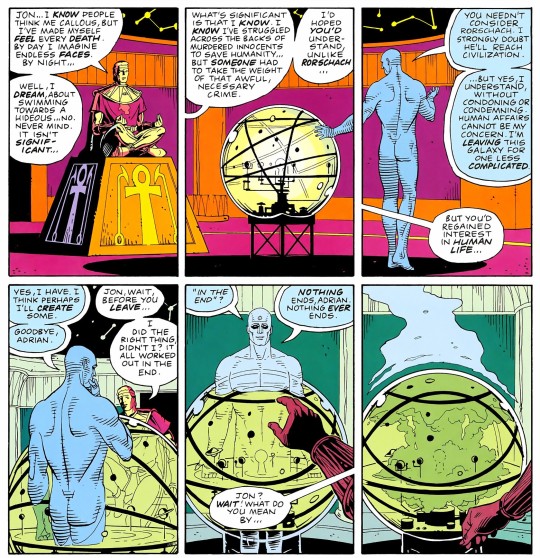
Sometime during Christmas, Laurie and Dan, who have assumed new identities, visit Sally Jupiter. Laurie tells Sally that she knows Edward Blake is her real father. She explains to her mother that she understands the complex relationship between Sally and Blake and that she has comes to terms with that. Laurie and Dan soon leaves while indicating that they would continue to adventure, although Laurie expressed the wish for a better superhero identity, a more protective leather outfit, a mask, and a firearm much like The Comedian.
In New York that which has been recovering from the disaster, the editor at New Frontiersman, Hector Godfrey, complains about having to pull a two-page column about Russia due to the new political climate. He asks his assistant Seymour to find some filler material from the "crank file", a collection of rejected submissions to the paper, to write. Sitting on top of the pile of discarded submissions is Rorschach's journal.
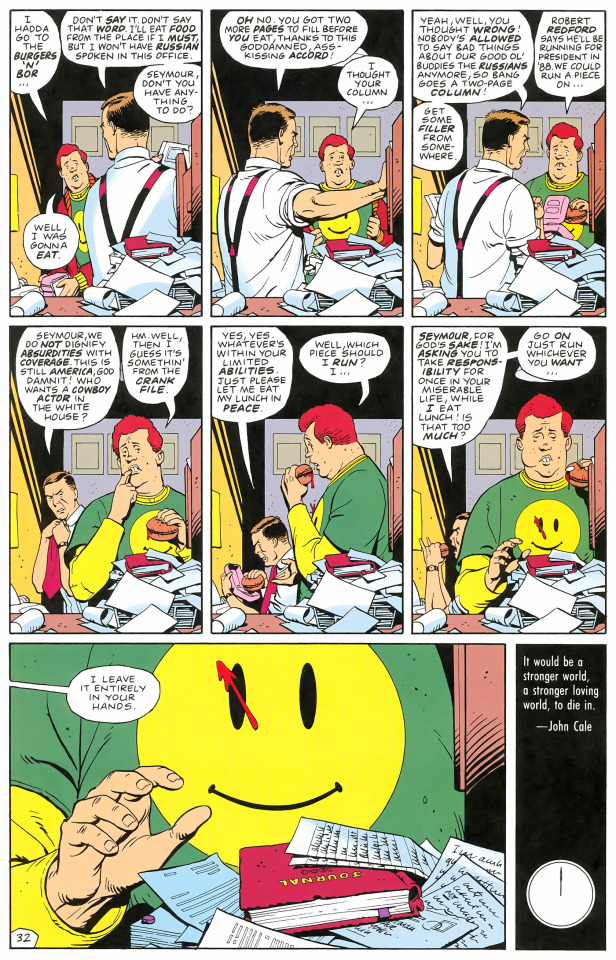
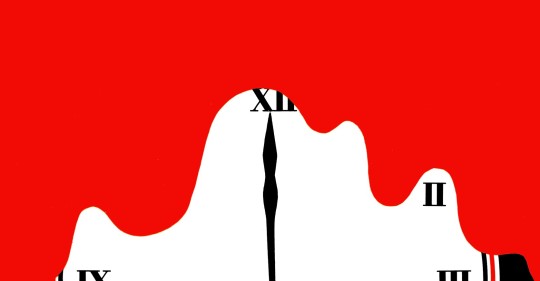
CRITICAL RECEPTION (FROM WIKIPEDIA)
Watchmen was first mentioned publicly in the 1985 Amazing Heroes Preview. When Moore and Gibbons turned in the first issue of their series to DC, Gibbons recalled, "What really clinched it [...] was [writer/artist] Howard Chaykin, who doesn't give praise lightly, and who came up and said, 'Dave what you've done on Watchmen is fuckin' A.'" Speaking in 1986, Moore said, "DC backed us all the way [...] and have been really supportive about even the most graphic excesses". To promote the series, DC Comics released a limited-edition badge ("button") display card set, featuring characters and images from the series. Ten thousand sets of the four badges, including a replica of the blood-stained smiley face badge worn by the Comedian in the story, were released and sold. Mayfair Games introduced a Watchmen module for its DC Heroes Role-playing Game series that was released before the series concluded. The module, which was endorsed by Moore, adds details to the series' backstory by portraying events that occurred in 1966.
Watchmen was published in single-issue form over the course of 1986 and 1987. The limited series was a commercial success, and its sales helped DC Comics briefly overtake its competitor Marvel Comics in the comic book direct market. The series' publishing schedule ran into delays because it was scheduled with three issues completed instead of the six editor Len Wein believed were necessary. Further delays were caused when later issues each took more than a month to complete. One contemporaneous report noted that although DC solicited issue #12 for publication in April 1987, it became apparent "it won't debut until July or August".
After the series concluded, the individual issues were collected and sold in trade paperback form. Along with Frank Miller's 1986 Batman: The Dark Knight Returns miniseries, Watchmen was marketed as a "graphic novel", a term that allowed DC and other publishers to sell similar comic book collections in a way that associated them with novels and dissociated them from comics. As a result of the publicity given to the books like the Watchmen trade in 1987, bookstore and public libraries began to devote special shelves to them. Subsequently, new comics series were commissioned on the basis of reprinting them in a collected form for these markets.
Watchmen received critical praise, both inside and outside of the comics industry. Time magazine, which noted that the series was "by common assent the best of breed" of the new wave of comics published at the time, praised Watchmen as "a superlative feat of imagination, combining sci-fi, political satire, knowing evocations of comics past and bold reworkings of current graphic formats into a dystopian mystery story". In 1988, Watchmen received a Hugo Award in the Other Forms category.
OWNERSHIP DISPUTES (FROM WIKIPEDIA)
Disagreements about the ownership of the story ultimately led Moore to sever ties with DC Comics. Not wanting to work under a work for hire arrangement, Moore and Gibbons had a reversion clause in their contract for Watchmen. Speaking at the 1985 San Diego Comic-Con, Moore said: "The way it works, if I understand it, is that DC owns it for the time they're publishing it, and then it reverts to Dave and me, so we can make all the money from the Slurpee cups." For Watchmen, Moore and Gibbons received eight percent of the series' earnings. Moore explained in 1986 that his understanding was that when "DC have not used the characters for a year, they're ours." Both Moore and Gibbons said DC paid them "a substantial amount of money" to retain the rights. Moore added, "So basically they're not ours, but if DC is working with the characters in our interests then they might as well be. On the other hand, if the characters have outlived their natural life span and DC doesn't want to do anything with them, then after a year we've got them and we can do what we want with them, which I'm perfectly happy with."
Moore said he left DC in 1989 due to the language in his contracts for Watchmen and his V for Vendetta series with artist David Lloyd. Moore felt the reversion clauses were ultimately meaningless because DC did not intend to let the publications go out of print. He told The New York Times in 2006, "I said, 'Fair enough,' [...] 'You have managed to successfully swindle me, and so I will never work for you again.'" In 2000, Moore publicly distanced himself from DC's plans for a 15th anniversary Watchmen hardcover release as well as a proposed line of action figures from DC Direct. While DC wanted to mend its relationship with the writer, Moore felt the company was not treating him fairly in regards to his America's Best Comics imprint (launched under the WildStorm comic imprint, which was bought by DC in 1998; Moore was promised no direct interference by DC as part of the arrangement). Moore added, "As far as I'm concerned, the 15th anniversary of Watchmen is purely a 15th Anniversary of when DC managed to take the Watchmen property from me and Dave [Gibbons]." Soon afterward, DC Direct cancelled the Watchmen action-figure line, despite the company having displayed prototypes at the 2000 San Diego Comic-Con International.
LEGACY (FROM WIKIPEDIA)
A critical and commercial success, Watchmen is highly regarded in the comics industry and is frequently considered by several critics and reviewers as comics' greatest series and graphic novel. In time, the series has also become one of the best-selling graphic novels ever published. Watchmen was the only graphic novel to appear on Time's 2005 "All-Time 100 Greatest Novels" list, where Time critic Lev Grossman described the story as "a heart-pounding, heartbreaking read and a watershed in the evolution of a young medium." It later appeared on Time's 2009 "Top 10 Graphic Novels" list, where Grossman further praised Watchmen, proclaiming "It’s way beyond cliché at this point to call Watchmen the greatest superhero comic ever written-slash-drawn. But it’s true." In 2008, Entertainment Weekly placed Watchmen at number 13 on its list of the best 50 novels printed in the last 25 years, describing it as "The greatest superhero story ever told and proof that comics are capable of smart, emotionally resonant narratives worthy of the label 'literature'." The Comics Journal, however, ranked Watchmen at number 91 on its list of the Top 100 English-language comics of the 20th century.
In Art of the Comic Book: An Aesthetic History, Robert Harvey wrote that, with Watchmen, Moore and Gibbons "had demonstrated as never before the capacity of the [comic book] medium to tell a sophisticated story that could be engineered only in comics". In his review of the Absolute Edition of the collection, Dave Itzkoff of The New York Times wrote that the dark legacy of Watchmen, "one that Moore almost certainly never intended, whose DNA is encoded in the increasingly black inks and bleak storylines that have become the essential elements of the contemporary superhero comic book," is "a domain he has largely ceded to writers and artists who share his fascination with brutality but not his interest in its consequences, his eagerness to tear down old boundaries but not his drive to find new ones." Alan Moore himself said his intentions with works like Marvelman and Watchmen were to liberate comics and open them up to new and fresh ideas, thus creating more diversity in the comics world by showing the industry what could be done with already existing concepts. Instead it had the opposite effect, causing the superhero comic to end up stuck in a "depressive ghetto of grimness and psychosis". In 2009, Lydia Millet of The Wall Street Journal contested that Watchmen was worthy of such acclaim, and wrote that while the series' "vividly drawn panels, moody colors and lush imagery make its popularity well-deserved, if disproportionate", that "it's simply bizarre to assert that, as an illustrated literary narrative, it rivals in artistic merit, say, masterpieces like Chris Ware's 'Acme Novelty Library' or almost any part of the witty and brilliant work of Edward Gorey".
Watchmen was one of the two comic books, alongside Batman: The Dark Knight Returns, that inspired designer Vincent Connare when he created the Comic Sans font.
In 2009, Brain Scan Studios released the parody Watchmensch, a comic in which writer Rich Johnston chronicled "the debate surrounding Watchmen, the original contracts, the current legal suits over the Fox contract".
In September 2016, Hasslein Books published Watching Time: The Unauthorized Watchmen Chronology, by author Rich Handley. The book provides a detailed history of the Watchmen franchise.
In December 2017, DC Entertainment published Watchmen: Annotated, a fully annotated black-and-white edition of the graphic novel, edited, with an introduction and notes by Leslie S. Klinger (who previously annotated Neil Gaiman's The Sandman for DC). The edition contains extensive materials from Alan Moore's original scripts and was written with the full collaboration of Dave Gibbons.
THE FILM
There are three versions of the Watchmen movie. The theatrical (that I watched several time at cinemas, including IMAX), a director’s cut (includes an extra half hour of movie) and the Ultimate Cut, which includes all the Black Freighter scenes.
I would recommend the theatrical version. I recently watched the ultimate version and the Black Freighter scenes do not work with the movie and also do not work with its altered ending. Hollis Mason’s death scene also feels even more disconnected to the story.
But even the theatrical version... I would say... I do not recommend you to watch it if you haven’t read the novel. The movie is a piece of beauty, visually, but the script feels a lot like they tried very hard to keep the original dialogues, and every time they change something you notice, because something feels out of place (even if you are watching it with fresh eyes).
REVIEW
What else can I add?
As a fan, I find it uneasy that only Gibbons can enjoy the credit for this story in all the adaptations, as Moore does not want to be mentioned in any of those (instead, they always say “co-created by Dave Gibbons”). It makes me feel dirty for buying the book a couple of times, and watching the movies (also V for Vendetta).
But beyond that, this is a piece of art, a very sophisticated piece of art. It’s what comics should aspire to be. Not every comic-book should... but I would love seeing something like this more often.
The series was made with great level of detail. To the point where you can spend minutes on pages or panels, finding things. In this last issue, the first look at New York, after the peace accord, is a whole new world full of details that tell you a story. This is why Watchmen is the perfect graphic novel, and has so much problem being adapted to other mediums or even having prequels and sequels. It was designed in a way that makes sense in these 12 issues of visual entertainment, where writing and art tell a complete story, but wouldn’t be the same if you had a novelization of it.
It was made for comic-books. You could do an adaptation to film with the same level of detail, but you wouldn’t be able to enjoy it, pausing to find all the details in every frame. Instead, they would have to find a new way of adapting this highly detailed and three-dimensional world.
I recommend buying the “Watchmen Annotated” edition as well, as a supplementary book to the regular one (or absolute, depending which version you have).
I give Watchmen a score of 10, and you should read it at least twice before you die.
#alan moore#dave gibbons#john higgins#dc comics#comics#review#1987#modern age#doctor manhattan#rorschach#nite owl#silk spectre#ozymandias#bubastis#world war iii#new frontiersmen#vertigo comics
9 notes
·
View notes